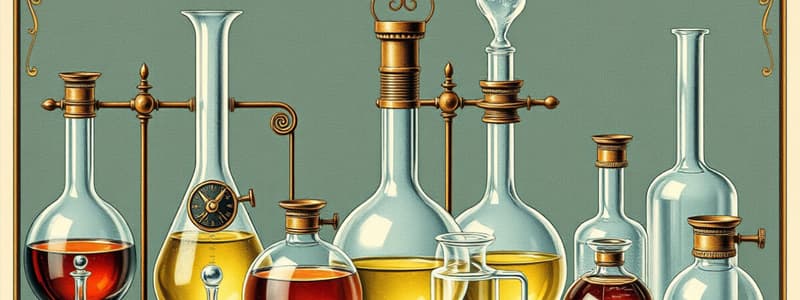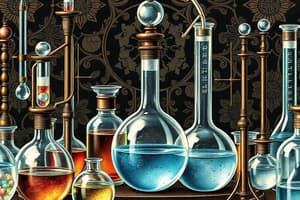Podcast
Questions and Answers
What is the primary function of safety goggles in a laboratory setting?
What is the primary function of safety goggles in a laboratory setting?
- To limit exposure to harmful odors
- To protect the eyes from splashes and projectiles (correct)
- To improve visibility during experiments
- To prevent static electricity build-up
How do gloves contribute to laboratory safety?
How do gloves contribute to laboratory safety?
- They protect hands from chemicals and biohazards (correct)
- They are used to handle hot equipment safely
- They enhance grip on laboratory equipment
- They provide insulation against electricity
What is the main purpose of a fume hood in a laboratory environment?
What is the main purpose of a fume hood in a laboratory environment?
- To ventilate hazardous fumes and gases during experiments (correct)
- To keep the laboratory clean and organized
- To provide extra storage space for chemicals
- To cool down heated equipment quickly
Which laboratory equipment is specifically designed to protect clothing from spills and stains?
Which laboratory equipment is specifically designed to protect clothing from spills and stains?
When categorizing laboratory apparatus, what is the key consideration for classification?
When categorizing laboratory apparatus, what is the key consideration for classification?
What primary function does a microscope serve in the laboratory?
What primary function does a microscope serve in the laboratory?
Which type of microscope is specifically designed for viewing samples with higher resolution?
Which type of microscope is specifically designed for viewing samples with higher resolution?
When preparing a sample for a microscope, what is typically required to ensure clarity and detail?
When preparing a sample for a microscope, what is typically required to ensure clarity and detail?
What is a common application of a microscope in biological research?
What is a common application of a microscope in biological research?
What type of lens is typically found in a microscope to enhance the viewing experience?
What type of lens is typically found in a microscope to enhance the viewing experience?
Flashcards are hidden until you start studying
Study Notes
Glassware
- Beakers: Versatile containers for holding, mixing, and heating liquids.
- Erlenmeyer Flasks: Conical flasks ideal for mixing and storing liquids, providing stability.
- Test Tubes: Small cylinders for holding small liquid volumes or conducting experiments.
- Petri Dishes: Shallow circular dishes used for culturing microorganisms or executing small-scale experiments.
- Graduated Cylinders: Tall, calibrated containers for accurate liquid volume measurement.
- Volumetric Flasks: Designed for preparing solutions with precise volume calibration.
- Pipettes: Slender tubes for transferring small liquid quantities accurately.
- Funnels: Conical tools to facilitate pouring liquids into containers with small openings.
- Watch Glass: Concave glass for holding solids, evaporating liquids, or heating small substances.
- Crucible: Heat-resistant vessel for containing materials at high temperatures.
- Mortar and Pestle: Tools for grinding solids into fine powders.
- Wash Bottle: Squeeze bottle with nozzle for rinsing glassware and sterilization.
Heating and Temperature Control
- Bunsen Burner: Gas burner for heating substances in laboratory settings.
- Hot Plate: Flat surface for heating containers or substances safely.
- Water Bath: Container filled with water to maintain constant temperature for samples.
- Thermometer: Device for measuring temperature in Celsius or Fahrenheit.
- Incubator: Regulates environment for optimal microorganism growth and cultivation.
- Hot Air Oven: Heats materials at high temperatures for sterilization and drying.
Measuring and Analysis
- Analytical Balance: Precision balance for measuring small solid masses.
- Triple Beam Balance: Measures mass using three beams marked with gram increments.
- pH Meter: Electronic device that measures solution acidity and alkalinity.
- Spectrophotometer: Analyzes light absorbance or transmittance for quantitative studies.
- Colorimeter: Determines color intensity, useful in colorimetric analysis.
- Microscope: Allows viewing small objects or specimens at high magnifications.
- Centrifuge: Spins samples to separate components by density.
- Filter Paper: Porous paper employed for filtration, separating solids from liquids.
- Gas Chromatograph: Analyzes gas mixtures for identification and quantification.
- Liquid Chromatograph: Separates and analyzes liquid mixtures by their components.
- Refractometer: Measures liquid refractive index to assist in substance identification.
- Titrator: Automates titration for accurate volumetric analysis.
- Microplate Reader: Measures absorbance or fluorescence in microplates for high-throughput assays.
- Conductivity Meter: Assesses electrical conductivity of a solution, indicating ionic strength.
- Geiger-Muller Counter: Detects and measures radioactivity in samples.
Other Equipment
- Tongs: Handy for grasping harmful objects or handling hot vessels.
- Spatula: Small tool for scooping and transferring solid materials.
- Magnetic Stirrer: Uses magnetic fields to stir solutions without physical contact.
- Desiccator: Sealed container with drying agents to keep substances moisture-free.
- Autoclave: Sterilizes equipment using high-pressure steam.
- Vacuum Pump: Creates vacuums for filtration or drying applications.
Chemical Equipment
- Kipp's Apparatus: Prepares small gas volumes by reacting solids with liquids.
- Chromatography Apparatus: Conducts chromatography using paper sheets as adsorbents.
- Copper Calorimeter: Measures heat changes during chemical or physical reactions.
- 3D Periodic Table: Interactive display showing element arrangement by atomic number.
Physical Equipment
- Reflection of Sound Apparatus: Demonstrates the second law of reflection.
- Slinky Spring: Used to determine pulse velocity through the medium.
- Ohm's Law Apparatus: Studies voltage-current relationships in resistors.
- Gold Leaf Electroscope: Detects electrical charge presence and its nature.
- Dynamo Model: Illustrates electromagnetic induction principles.
- Electric Motor Model: Shows conversion of electrical energy into mechanical energy.
- Kaleidoscope: Demonstrates multiple reflection phenomena.
- Multimeter: Measures voltage, current, resistance, and other electrical values.
- Periscope: Optical tool for observing objects that are out of direct line of sight.
- P-N Junction Diode Apparatus: Observes diode V-I characteristics.
- Zener Diode: Conducts in reverse at specific voltage for voltage regulation.
Safety Equipment
- Safety Goggles: Protect eyes from splashes and flying debris.
- Lab Coat: Safeguards clothing from spills and stains.
- Gloves: Protect hands from harmful chemicals and biological hazards.
- Fume Hood: Ventilates hazardous fumes and gases safely during experimentation.
Studying That Suits You
Use AI to generate personalized quizzes and flashcards to suit your learning preferences.




